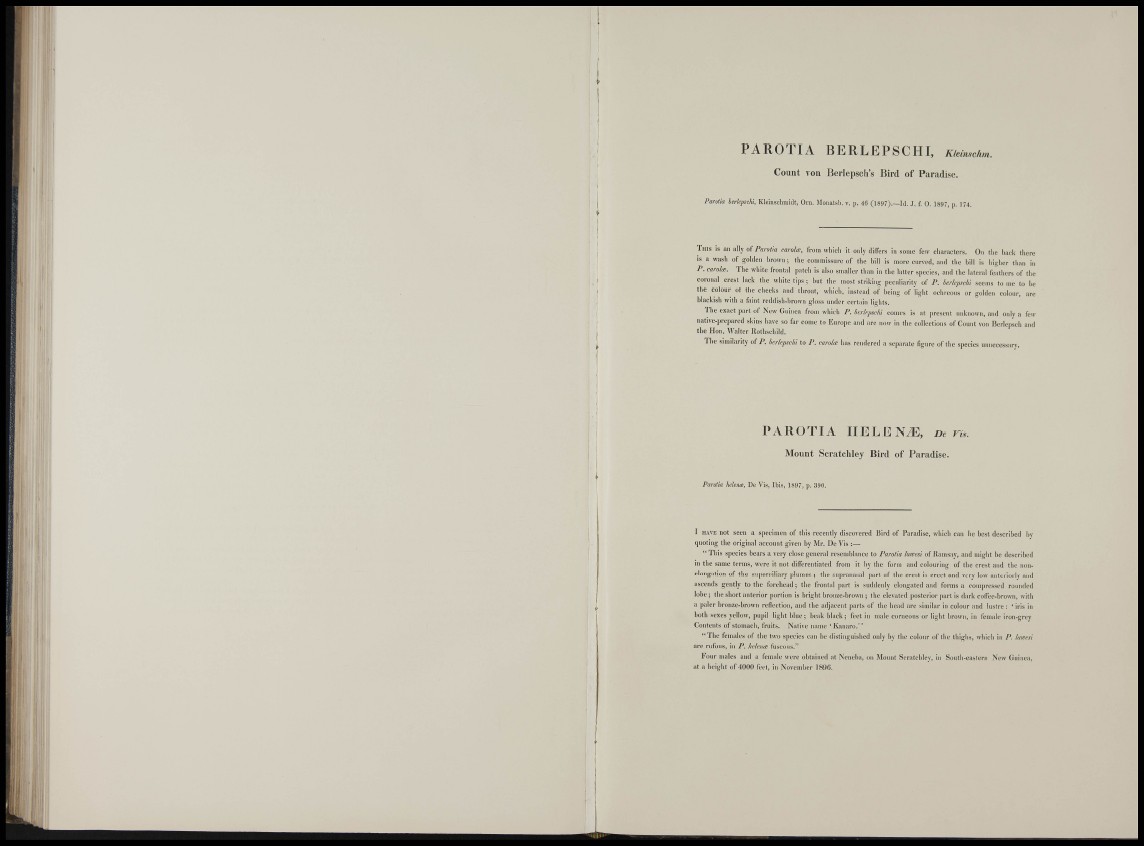
PAROTIA BERLEPSCHI, A/eWm.
Count von Berlepsch's Bird of Paradise.
Parotia lerkpscM, Kleinschmidt, Ora. Monatsb. v. p. 46 (1897).—Id. J, f. O. 1897, p. 174.
THIS is an aWy of Parotia carolai, from vvliich it only clilTers In some few characters. On tlie liack there
is a wash of ifolden brown; the commlssnre of the hill Is more enrved, and the bill Is higher than in
1'. carolte. The white frontal patch is also smaller than in the latter species, and tlie lateral feathers of the
coronal crest lack the white tips ; but the most striking pecnliarity of P. herkpschi seems to me to he
the colour of the cheeks and throat, which, instead of heirig of light ochreons or golden colour, are
blackish with a faint reddish-hrown gloss under certiiin lights.
The exact part of New Giiinea from which P. bcrlepschi comes is at present unknown, and only a few
native-prepared skins have so far come to Europe and are now in the collections of Count von Berlepsch and
t h e Hon. Walter Rolhscljild.
The similarity of P . bcrlepschi to P. carolce has rendered a separate figure of the species unnecessary.
PAROTIA HELENiE, De Vis.
Mount Scratchley Bird of Paradise.
Parotia helena. De Vis, Ibis, 1897, p. 390.
I HAVE not seen a specimen of this recently discovered Bird of Paradise, which can be best described hv
quoting the original account given by Mr. De Vis :—
" Tliis s|)ecies bears a very close general reseuihlance to Parotia lawesi of Uamsay, and might be described
in the same terms, were it not differentiated from it by the form and colouring of the crest and the nonelongation
of the superciliary plumes ; the supraiiasal part of the crest is erect and very low anteriorly and
ascends gently to the forehead ; the frontal j)art is suddenly elongated and forms a compressed rounded
lobe ; the short anterior jwrtion is bright bronze-brown ; I he elevated posterior part is dark coffee-brown, with
a paler brouze-hrown rellection, and the adjacent parts of the head are similar in colour and lustre: 'iris in
both se.\es yellow, pupil light blue; beak black; feet in male corneous or light brown, In female iron-grey
Contents of stomach, fruits. Native name ' Kanaro."
" T h e females of the two species can be distinguished only by the colour of the thighs, which in P. laaesi
are rufous, in P. hcleuiE fuscous."
Four males aiul a female were obtained at Neneba, on Mount Scratchley, ii] Soutli-eastern New Guinea,
at a height of 4000 feel, in November 1890.